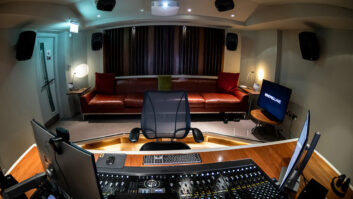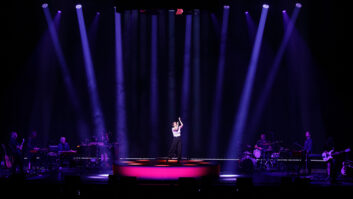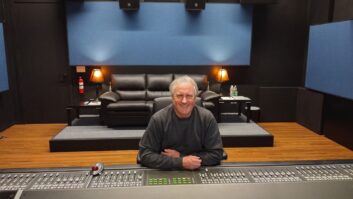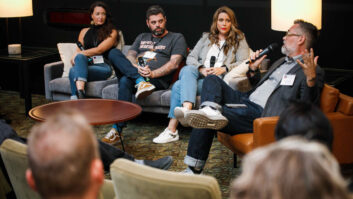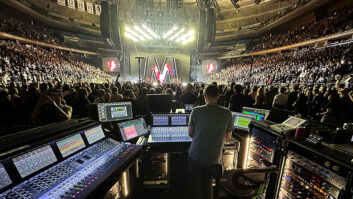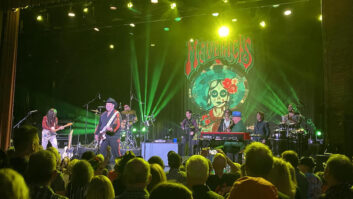
Chris Jenkins (seated) and Frank Montano worked on Watchmen.
Given the complexity of high-action movies, and the fact that technology-savvy directors retain their creative options right up to the final print-mastering stage, re-recording mixers face some difficult choices. “As soon as I had read the script for Watchmen, I knew that we could use an extra three to four weeks on the mix,” recalls Chris Jenkins, who, with Frank Montano handling sound-effects tracks, mixed dialog and music for director Zack Snyder’s film about costumed super-heroes in the dystopian world of an alternate America. “But you never get the luxury of working in a linear fashion on a very special effects-heavy film that won’t be locked [until close to print mastering]. The schedule just didn’t allow us that luxury; it’s always fluid. We joke now that picture and predubs aren’t locked; instead, they are ‘latched’ — the film is fastened together, but not necessarily glued together!”
Typically, an effects-laden motion picture will be assigned an eight- to 10-week mix schedule, with five to seven days of dialog predubs and 15 to 20 days of effects predubs, followed by a four- to six-week re-recording and print-mastering schedule. During predubbing, the myriad component elements prepared by the film’s sound-editorial team will be submixed into either a left-center-right perspective or a full 5.1-channel surround sound balance.
The Jenkins- and Montano-helmed mixing project for Watchmen ranged over a total of three dub stages at the Universal Studios lot in preparation for a 5.1-channel surround sound mix, a 2.5-hour IMAX version, which Jenkins supervised in Toronto, plus a DVD Director’s Cut and a second 3.5-hour DVD that included a pair of additional features on the movie’s comic-book origins and complex back story. “Once we had seen the movie,” Jenkins continues, “Frankie [Montano] started to make a map with the supervising sound editor on how he was going to lay out his predubs.
“I like to start at least three days — maybe a week — ahead of him. If they want Frankie to get started as well, he might start with Foley predubs or something like that while I get started on my dialog. But we try and rebel [against that idea]. I like to prepare one to two production-dialog predubs, a couple of ADR predubs and a group predub for at least three reels so that Frankie can be running those into the monitors as be begins his effects predubs and can design his mixes around the dialog. He’ll build between 12 and 14 predubs for separation, but I wait to do my group walla until the end of the predub schedule.
“The idea is that when you’re building the architecture of the soundtrack, you are also building the final mix desk. And Frankie is also writing automation data when he’s building his predubs. Because our [Harrison] consoles have 512 inputs, Frankie can put up the dialog predubs and then volume-graph my sessions to make any overall dialog-mix refinements as he goes; that information stays with the session. Then he starts adjusting his effects tracks against those levels, all the time writing automation data. It is important that we are able to put up a reel that has maybe 30 predubs and music and play the whole [soundtrack] for the director.”
“We had maybe 300 channels of effects on some of the busier reels,” Montano recalls. “For some of those reels, my working in parallel with Chris lets me ‘shape’ the Foley and hard effects around the premixed dialog.”
“Watchmen was a very extended project; our final mix was five or six weeks,” Jenkins offers. “In theory, as soon as I have completed a reel of predubs and Frankie has completed a reel of effects predubs — five days into the premix stage — we can play a trial mix for the director. We also did three or four temp mixes, I recall.”
To handle the two extended DVD mixes needed for Watchmen, Jon Taylor and Christian P. Minkler mixed, respectively, dialog/music and effects on Universal’s Dub 6 stage. “There was 25 minutes of new footage used on the two DVD projects,” Jenkins explains. “We cloned our mixes for Jon and Chris [available over a SAN network], who added several transitions for the Black Freighter animated feature [and other bonus material]. The studio wanted everything done simultaneously, with the full complement of M&Es and foreign-language mixes on all of the four soundtracks. We were working on the Watchmen project for a total of five months.”
“The key to successful predubbing,” Montano states, “is that all three consoles at Universal — Hitchcock, Dub 6 and Dub 3 — match the same technical footprint. We are able to send console automation over Fibre-Channel networks, along with access to the source elements and stems [available as Pro Tools sessions]. We can also edit each other’s automation data across all MPC Series consoles used for predubbing and final mixing. Actually, when I’m premixing on one side of the desk, I’m also making final passes on the effects section as I go.”
“In terms of passes under automation,” Jenkins adds, “five years ago we might be making 200 passes through finals; these days, we are doing 2,000 passes, maybe more on some larger films. So when I sit down with Frankie on day one of final mixing, he already has between 300 and 400 passes of console automation on his effects section, as he is balancing hard effects against backgrounds, and then Foley against that. Consequently, a lot of his ideas are there in polished form, even at the start of finals. It saves a lot of time.”

Greg Russell: “If you give 10 different people the same elements, you’ll get 10 different predub mixes!”
INCREASING CREW COUNT
Seasoned re-recording mixer Tom Fleischman is more used to working New York-style on film projects, riding solo on dialog, music and effects. “But these days,” he notes, “with so many effects tracks it is simply too much for one person to oversee, so even in New York some projects have moved to two-man crews. Also, in New York the supervising sound editors or effects editors often prepare sound effects predubs for me. The downside is that these predubs are not usually balanced against the dialog predubs, which means more work for me at the final mix stage.
“On Angels & Demons, which I mixed at Sony Pictures Studios on the West Coast with Greg Russell [effects], we had a lot of foreign languages that needed to be kept separate for the international versions. For these [M&Es,] we needed to separate the various languages spoken in the film, so I created predub channels for English, Italian, Latin, Spanish and German. We had around 30 dialog tracks, where normally I might have around 16. I prefer to create my own dialog predubs so that I know where everything is and how all of the original production tracks were processed.”
Because the results need to be shaped so specifically for the film he will be mixing, Russell prefers to handle effects predubbing himself. “If you give 10 different people the same elements, you’ll get 10 different predub mixes!” he says. “It is hard to take something that somebody else has done for you; if it’s not what you need it to be, you end up having to ask for the original elements.
“For Angels & Demons, I had around 14 days to predub the hard effects and backgrounds — crowds and so on, of which we had a lot! I ended up with nine BG predubs across several [film] locations. While Tom was handling his dialog and ADR predubs on Stage 1/Cary Grant Theatre at Sony, I was doing effects on Stage 2. We needed an additional stage to do Foley, so Jeff Haboush predubbed [those tracks] because he’s an excellent mixer and familiar with how I like Foley to sound.
“Supervising sound editor ‘Chic’ Ciccolini and [sound designer] Danny Pagan did a fantastic job of assembling a nice palette of sounds for me to work with,” Russell continues. “For example, they provided vehicle-effects elements in a number of food groups, including motors, tires, cobble squeals, skids and so on, which I mixed into three predubs: a 5.1 of doors, a 5.1 of motors and a 5.1 of tires, with reverb as necessary, plus individual skids and special sounds, all playing back off Pro Tools. I also had 30 to 40 tracks of guns that I mixed to four 5.1-channel predubs of ‘good guns,’ ‘bad guns,’ bullet whizzes, and bullet ricochets and impacts. In all, I ended up with 12 hard-effects predubs for the final mix, where I used groupers to control the overall levels of each predub against Tom [Fleischman’s] dialog premixes. Since some of the visual effects had not been completed by finals — and there were many picture changes at the end of the film in the Vatican scenes — we had to sweeten the entire scene from scratch while we were finaling. There are always a lot more challenges in a big sound-effects movie.”

The 2012 crew at William Holden Theatre (Sony Pictures Studios), from left: Adrian Van Velsen, Fernand Bos, Rick Kline/music mixer, Paul Ottosson/supervising sound editor, David Brenner, Jeff Haboush/dialog mixer, Michael Keller/effects mixer, Michael Benavente/dialog and ADR supervisor and Fred Peck
Another effects-heavy film scheduled for November release also had its sound crew working long hours to complete predubs. Roland Emmerich’s 2012 was mixed on the William Holden Theatre at Sony Pictures Studios with Jeff Haboush handling dialog, Michael Keller effects and Rick Kline music, with supervising sound editor Paul Ottosson. “Like most high-intensity movies,” Haboush recalls, “we were using two stages for predubs: William Holden Theatre for sound effects and the Anthony Quinn Theatre, which was handling dialog and Foley premixes. I prepared a pair of dialog predubs and an ADR remix in Pro Tools, while composer [and writer/co-producer] Harold Kloser gave us 52 channels of music. Mike [Keller] prepared 26 5.1-channel effects predubs, plus five BG predubs and individual footfalls. For finals, we maxed out the Harrison MPC console [in the William Holden Theatre] with 250 tracks of effects, 64 of music and 64 of dialog.
“But during finals, we were still missing a lot of CGI footage,” Haboush continues, “and so we had to spend the evenings predubbing those reels [while finaling during the day]. We started off with a 30-day schedule, which, after 20 days, we knew would be short, so it was extended to 37. In the end, because there was a large amount of special effects during the destruction scenes, we spent 40 day-equivalents on predubs and maybe 25 on finals. While we could look at wire-frame [images] for some of the high-impact scenes — exploding volcanoes and major city destructions, for example — you can never fully cover the details that a final CGI will reveal. For instance, because we had a lot of rock sounds that needed to be predubbed for the volcano scenes, we had to reconfigure to accommodate new visuals, which we checker-boarded across six 5.1-channel predubs. It was a major time crunch, and will be right through our mid-August print mastering.”
“Having the supervising sound editor providing pre-panned effects tracks was a great help,” Keller reflects. “Paul [Ottosson] gave me maybe 100 car elements for the big ‘Destruction of L.A.’ sequence that had already been panned across his LCR and 5.1 Pro Tools sessions. I could then combine Paul’s 10 predubs into a single blended predub; otherwise, having to pan each individual car sound would have taken a lot of time, which we just didn’t have!”
DUAL MIX TEAMS NO A HIGH-ACTION PRODUCTION

Anna Behlmer and Andy Nelson jumped from Australia to Star Trek: The Future Begins.
Unusually, during the re-recording of Star Trek: The Future Begins, a second dubbing crew took over re-recording chores after the project had started predubbing with Paul Massey and David Giammarco. Director J.J. Abrams had worked with Andy Nelson and Anna Behlmer from Fox Studios on several of his previous films, including Mission Impossible III and Cloverfield. “But since we had been hired previously to work in Sydney on Australia,” Nelson says, “J.J. had started with another crew. When we were freed up from Australia, we were able to join the project with Paul and Dave, who had been working on predubs for several weeks.”
“It’s not the optimum way of working,” considers Behlmer. “But because of the tight schedule, we had to move the project along. ‘Needs must,’ as they say.” Effects predubs are, by their nature, particularly complex on a film like Star Trek, “so finding what is where [on the predub mixes] can take some time,” she offers.
“Having access to three identically equipped stages — Howard Hawks, John Ford, which is Paul Massey’s room, and Robert Wise Theatres — helps a lot,” adds Nelson, who also serves as VP of sound operations at Fox Post-Production Services. “Predubs from any of the rooms sound exactly the same in any other area, and the automation data from our [AMS Neve] DFC consoles is fully transportable. I ended up with six dialog predubs, including original production dialog, ADR and a pair of group walla [tracks]; I did redo a couple of these mixes, but preferred to use the existing predubs where we could. Music was delivered as six or seven 5.1-channel stems, plus solo instruments, et cetera. Anna had a total of 44 predubs, all of which were 5.1 channels wide.
“We also needed to predub new effects elements that came in from [sound designer] Ben Burtt,” Nelson continues, “which brought to the film some of the iconic sounds from the original TV show. [Supervising sound editor] Mark Stoeckinger also supplied a number of new elements. Eventually, we whittled down the total number of effects predubs to 36, which is still a lot to handle during finaling.”
Combining editorial/design with re-recording functions also offers creative advantages. With an extensive background in sound design and sound-effects mixing, Myron Nettinga used his skills while developing predubs for director Jonathan Mostow’s film Surrogates at Sony’s editorial facility prior to the mix at Walt Disney Studios. “Because of my experience as a mixer,” he says, “I’m able to use those sensibilities while making creative choices during designing that will carry through to the final mix. I know what I will want for separation, panning, delays and reverb, with a good understanding of how it will translate on the final stage.” Working closely with supervising sound editor Jon Johnson, Nettinga developed predubs while designing sound for a number of action sequences and other selected scenes.
“I will still be doing more predubbing at Disney before the final mix,” he continues, “but it was great to have built and predubbed some of the larger and busier sequences early on. I see the approach of working earlier in the process in smaller rooms becoming more the norm. [It is] similar to the music stems that currently come to the stage for the final mix and which have been premixed in smaller control rooms by the scoring mixer. It’s a great way to work with budgets and schedules that may not always be optimum, without sacrificing quality.”
Most re-recording mixers are reluctant to work with predubs that have been produced by somebody else, unless they have worked closely with the mixer in the past and share similar sensibilities, or are supervising their choices. “We try not to predub each other’s material if possible,” Jenkins confirms. “On one film where I couldn’t make it for predubbing, I offered to the director that probably it would be better if the same re-recording mixer took the project all the way through finals. There is just too much room for interpretation. I guess it’s 40-percent ego and 60-percent reality.
“If I don’t do the predubs I just don’t know what the problems were and what to look out for going into finals. I have a great auditory memory and ‘learn’ the film during premixes. For example, I might not clean up something or put on a particular reverb because I know that I could get to that later in the process. Somebody else might not do that; they may clean everything up for me. Making this sort of decision — and locking myself in — is something I’d prefer to do for myself!”
Mel Lambert heads up Media&Marketing (www.mediaandmarketing.com), a full-service consulting service for pro-audio firms and facilities.

